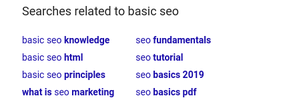Let's talk about SEO – Search Engine Optimization. A question about what you can do to get traffic from search engines like Google came up during one of our group coaching calls the other day and we promised to put what we shared into writing. While the article may look long, SEO Fundamentals are actually pretty simple and straightforward. There are just a few things you need to tweak to make sure search engines like Google notice what your content is about.
Read through the article and then get to work on a new blog post, following these six steps to tweak and change as needed to optimize. Always make sure you write for your audience first, and search engines second. Because at the end of the day, a well optimized and ranking article won't do you much good if it becomes unreadable for the intended target audience.
Step One – Choose Your Keyword Or Key Phrase
There are all sorts of tools out there that will research keywords for you and give you ideas for what you may want to rank for. Google's AdWords Keyword Planner is a good free tool to try, but if we're perfectly honest, we don't bother with it most of the time. The quickest and easiest way to find popular keywords and key phrases is Google. Here's how to do it.
Think of some keyword to begin. This would be something that covers the general idea of what your post or article is about. For this article I started with “basic seo”. Search for this key phrase in Google and scroll down to the bottom of the search page. You will find a section that starts with “Searches related to”. Here's what I got when I googled “basic seo”:

The one I chose to optimize this blog post for is SEO Fundamentals.
Step Two – Crafting A Title For SEO & Readers – The Most Important Of The SEO Fundamentals
Now that you have your keyword, it's time to get to work. The first thing you want to write is the title of your blog post or article. Adding your keyword to the title is by far the strongest SEO signal you can send. You want to include it if at all possible.
At the same time, your title is what makes someone decide if they want to click and read the post or not, so it needs to be attention grabbing as well. You want to strike a balance between SEO and Copywriting when it comes to crafting your title. I like to write the title first and then come up with a variation that includes my chosen keyword. If you can fit it in early in the title, that's great, but it's not always necessary. If in doubt, pick a title that appeals to your target audience.
Let's take a quick look at the title of this blog post: SEO Fundamentals – Let's Keep It Simple.
We're using our keyword first which is great. It's also a term we know people are looking for and by mentioning that we're keeping it simple, we add appeal to our target audience for this piece of content which is bloggers and content marketers who are new to SEO.
Now it's your turn. Look at your keyword and come up with a few different title ideas. Pick the one that you think will interest your readers and get to work on the rest of the post.
Step Three – Use That Keyword In Your Content
Next, it's time to start writing. Write your article for your readers first. Work your keyword into the first 100 words of your post, but make sure it flows and reads well. Don't force it. It's better to leave it out than to end up with a blog post that no one wants to read.
From there, continue to write and drop your keyword or key phrase in occasionally. You don't want to overdo this. Once or twice is all you need for shorter pieces of content. For a long article like this one, you can get away with mentioning it a little more often. An SEO plugin like Yoast SEO can help determine keyword density and suggest increasing or reducing the frequency. If you're not using a plugin, use it early in the post and then once or twice more. That's enough to get the point across to the search engines without annoying your readers.
By the way, Google has gotten pretty smart over the years. Their algorithm can recognize related words and phrases. That's great news because you can get more creative with your writing and craft blog posts your audience will enjoy reading.
Step Four – Break It Up With Images And Headings
An image says a thousand words. It can also help you make your content more readable and help with SEO. And it's not the only thing. Having headings like the ones we're using extensively in this post will help as well. Not only will they help with search engine optimization, they also make it easier to read and scan the article. Here are the rules you want to follow when it comes to using images and headings:
- Use your keyword or something related in the name of your image file.
- Write an alt tag that describes the image including your keyword if possible.
- Break up larger chunks of text with headings and subheadings. Include your keyword or related phrases where possible.
Preview your blog post before you hit publish and see if it is easy to scan across the image and headings to get an idea of what it's about. This will be helpful to readers as well as search engines. Using a plugin like Yoast SEO can help remind you to do this for every new post you publish.
Step Five – Internal Linking
Next you want some links from other pages of your own site pointing to this new content. This will help search engine spiders crawl the new stuff and start to index it. If you are using a content management system like WordPress, a lot of this internal linking is already taken care of. Your new post will show up on your home page, in the sidebar and on various category and archive pages.
To give your post a little extra boost and to start driving traffic to it, go find two or three related blog posts or articles you've written. Scan the content and work a mention of the new blog post in where it makes sense. This could be as simple as “Another way to get free traffic is to optimize your content for search engines. Read this article on SEO Fundamentals to get started”. In this case we would use SEO Fundamentals as the link text since it's the term we want to rank for.
Step Six – Social Signals And Income Links (Beyond SEO Fundamentals)
While this tutorial mostly covers on page SEO, we wanted to briefly mention the importance of incoming links and social signals. This goes a little past SEO Fundamentals, but it's easy to do. Let's go over it. Incoming links are links from other websites to yours. You can get these naturally as your content becomes popular across the web and has others linking to it because they like it. Craft great content that helps your readers out or entertains them and you'll start to see these coming up over time.
You can also create your own incoming links by writing articles and guest blog posts for other people that include a link back to your post. If you are already starting to rank well for a particular keyword, engineering a few strong incoming links could be just what you need to make it into one of the top spots on page one of Google.
Social signals are social media mentions. Share your latest blog post on Facebook and Twitter. Link to it from your Instagram profile for a little while. Create a few eye-catching graphics and post them to Pinterest with a link back to your post. Install a social media sharing plugin and encourage your readers and followers to share your latest post. That's all it takes to get some of those social signals that will show Google that your content is interesting and engaging.
There you have it. SEO Fundamentals aren't all that complicated and if you follow this simple step-by-step process a few times, it will quickly become second nature. There isn't a lot of extra work involved and just minor tweaks needed to turn your engaging blog post into one that may also start to rank in the search engines for a few keywords and key phrases.
We encourage you to write your blog posts for your target audience first and then make a few minor adjustments for search engine optimization. Do this consistently and you should start to see your traffic and reach increase.

